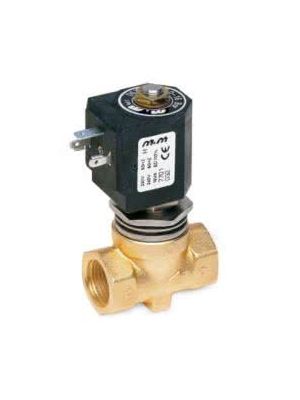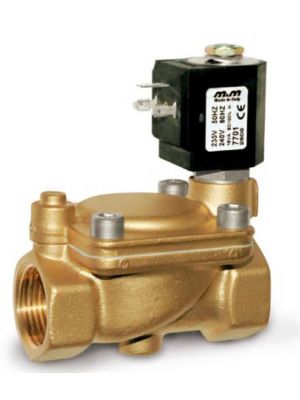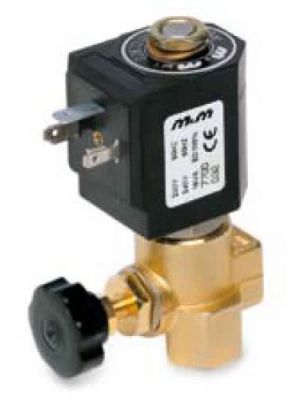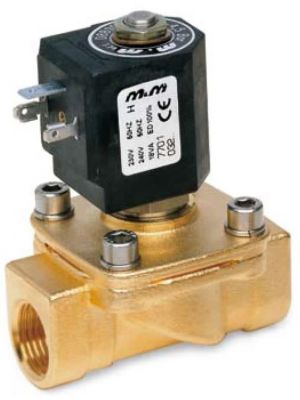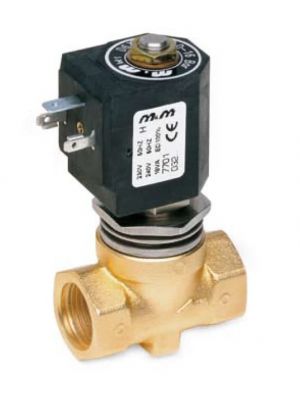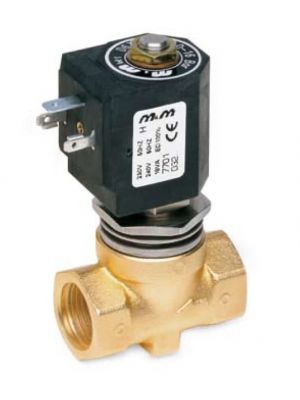
Steam valves & solenoid valves for hot water
A valve is used to control the flow through a pipe or hose. When open, it is completely permeable so that liquids or gases can easily pass through. However, when the valve is closed, it ensures a tight seal.
- 2-way servo-controlled piston valve, steam, G 1/2 ", brass, normally closed SKU:
D636DTTAs low as $ 103.79 - 2-way solenoid valve, steam, G 1 ", brass, normally closed, servo-controlled SKU:
D622DTYAs low as $ 192.50 - 2-way solenoid valve, steam, G 3/4 ", brass, normally closed, servo-controlled SKU:
D606DTYAs low as $ 192.50 - 2-way solenoid valve, steam, G 1/4 ", brass, with flow restrictor, direct operated SKU:
D267As low as $ 82.12 -
-
- 2-way solenoid valve, steam, G 1/4 ", brass, normally closed, servo-controlled SKU:
D887DPVAs low as $ 93.69 - 2-way piston valve, steam, G 3/8 ", brass, normally closed, servo-controlled SKU:
D635DTTAs low as $ 103.79 - 2-way piston valve, steam, G 1/4 ", brass, normally closed, servo-controlled SKU:
D634DTTAs low as $ 103.79
It is also possible to set intermediate positions. The line remains permeable, but the flow rate decreases due to the smaller opening. Simple versions are intended for manual control. However, this is quite complicated and in some cases requires considerable effort. In addition, this usually requires you to be in the immediate vicinity of the valve. However, you can avoid these problems by using a solenoid valve. Here an electromagnet exerts force on the closure to open or close it. This makes the control a lot easier. Furthermore, these devices allow connection to electronic control systems so that they are often used in fully automatic machines. In addition to the usual designs, there are also some models that are characterized by particularly high temperature resistance. Therefore, they are great for hot water and steam.
Special valves for hot media
If valves are intended for steam applications or for piping with hot water, it is necessary that they are temperature resistant. For this reason, products are usually used in which the valve body is made of brass. This metal has a high melting point so it can withstand heat without any problems. There is neither deformation nor material fatigue. Warm water is not only a burden for the components used due to the increased temperature, the combination of moisture and heat also promotes rust formation. But the material is also very suitable from this point of view. It is not just the valve body that has to withstand the high temperatures: In addition, special seals that are not damaged by heat are required. This is why PTFE is usually used here. This plastic is very heat-resistant and is therefore ideal for applications with hot media.
Areas of application for solenoid valves for hot water and steam
Hot water plays an important role in building services. It is used, for example, for personal hygiene or cleaning work. The central heating usually also works with hot water. Here it is always necessary to control the flow of the lines with a valve. However, hot water applications are not limited to building services: many machines also use water as a coolant. As a consequence, it heats up a lot. A corresponding valve can also provide valuable services in this area. In numerous applications, the water is heated so much that it evaporates. Numerous valves are also used in the field of steam technology. Generators generate electrical energy using steam pressure, for example. You need heat-resistant solenoid valves to control the relevant power plants. Many household appliances also use steam. This can be a steam iron or a steam cleaner. Heat-resistant valves are of great importance for the manufacture or repair of the corresponding products.
Hot water and steam valves with different designs
The valves that you will find in this category are exclusively models with 2/2 ways. Therefore there is only one inflow and one outflow. Further outputs, for example to release the pressure or to direct the water into another line, are not possible. One of the main differences between each offer is how large the diameter of the connections is. You can purchase valves for 1/8", 1/4", 3/8", 1/2", 3/4", or 1" piping. Another important point is how the valves behave in their normal state - when no voltage is applied. Many models are closed in this case and do not open until you connect the power source. With other versions, exactly the opposite is the case. If there is no current flowing through the electromagnet, they will not block the line. Finally, the opening mechanism of the valves can differ. In the case of directly controlled versions, the electromagnet moves the sealing element directly. Since a comparatively large force is required for this, large coils with a very high consumption are required. However, these models work completely independently of the pressure conditions in the pipe system. An alternative is to use servo-controlled valves. The magnet only moves a small pilot valve. Since little force is required for this, smaller electromagnets are sufficient for this task. The corresponding valve then ensures that the actual sealing element opens due to the forces generated by the pressure in the line system. However, it is important to ensure that this technique is only possible if there is a sufficiently large pressure difference between the areas in front of and behind the valve.
Important points when choosing the valves:
- Size of threads
- normally closed NC or normally opened NO
- Opening mechanism of the sealing element

